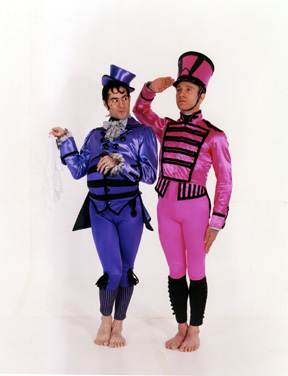Gods and Puppets
Mercuric
Tidings/Runes/Le Grand Puppetier
Paul Taylor Dance Company
City Center
New York, NY
March 4, 2004
by
Mary Cargill
copyright
© 2004 by Mary Cargill
 Taylor’s
typically well-balanced program combined light, darkness, and ambiguity.
Mercuric Tidings was sprightly and joyful;Runes, dark
and threatening; and Le Grand Puppetier, a premiere, was an ambitious—and
not totally successful—examination of power.
Taylor’s
typically well-balanced program combined light, darkness, and ambiguity.
Mercuric Tidings was sprightly and joyful;Runes, dark
and threatening; and Le Grand Puppetier, a premiere, was an ambitious—and
not totally successful—examination of power.
Mercuric Tidings, set to (unfortunately) taped excerpts from the 1st and 2nd symphonies of Franz Schubert, is the Taylor people love, a deceptively simple romp through a gentle, attainable heaven. Beautiful dancers in raspberry leotards walk, run, and gamble to gentle, lilting music. Simple, yes, but at times profoundly moving; the possibility of a rich, pure beauty is exalting. Of course, even in Taylor’s heaven, there is no unalloyed joy, and the elegiac second movement had an outsider, Michelle Fleet. She was not deliberately or cruelly excluded, she just seemed to be wishing for something not quite there in that harmonious community.
Runes, too, is about a community, but not a joyful one. It seems to pick up where Rite of Spring leaves off; it opens at night with a man lying on the stage, eventually surrounded by a primitive, almost insect like, group, who seem to be undertaking some sort of a ritual. Lisa Viola, that amazing powerhouse, appears to be a high priestess, and eventually members of the group alternate as victims. It is disturbing and very powerful.
Le Grand Puppetier is another riff of a famous Diaghilev ballet, Fokine’s Petrouchka. It uses a recorded pianola version of the Stravinsky score, a solution, perhaps, to the live music issue. The faintly tinny sound works well with the commedia dell’arte characters, and the bright, cartoonish costumes. But of course, Taylor is inviting, or perhaps demanding, a comparison with the Fokine work, and, at least in a single viewing, the new piece, accomplished as it is, does not match the ballet’s richness or complexity.
Patrick Corbin, in Pierrot-white, is a puppet on a chain, and his master, Richard Chen See, is in Napoleonic black. He is called the Emperor, but could also be Diaghilev, the Charlatan, or any other despot. He wants to marry his daughter—Lisa Viola at her deadpan best, in fluffy ringlets, made, it seems of iron, like a Shirley Temple with attitude to a purple-spangled fop, a prissy, handkerchief-wielding stereotype who is very obviously interested in a bright pink soldier. Corbin manages to steal the Emperor’s wand, the source, it appears, of his power, and free the slaves/other puppets.
Based on the work’s subtitle (“absolute power corrupts absolutely”), I guessed that the Puppet would become the master, a rather pat ending, but a bit more powerful than the one Taylor has. During the celebrations, the Puppet accidentally drops the wand of power, the Emperor picks it back up, and the populace becomes his slaves again. Is Taylor trying to say that acquiring power is just an accident? Or that it is useless to try to break free? In any event, the ending has none of the wild power of poor Petrouchka’s cry at the end of the ballet.
The dancing, it almost goes without saying, was very good. The slightly folk-flavored group dances looked like so much fun. No one can do daffy like Viola, and her go-for-broke jumps combined with her dizzy, slightly puzzled expression, was very funny, if reminiscent of her klutzy French grisette of Offenbach Overtures. Robert Kleinendorst, as the fop, was game, but he and his soldier inamorata, Andy LeBeau, too, brought to mind the soldier/sailor duet of Offenbach. Corbin, flopping ineffectively, was truly touching as the hapless puppet. It is not a perfect work, but no one, not even Taylor, can turn out great works year after year. But, as always, there is so much to see in even a partially successful work.
Read other reviews of the Paul Taylor City Center season:
Opening
night gala (Susan Reiter)
Program A (Leigh Witchel)
Program C (Nancy Dalva)
In the Beginning (George
Jackson)
Photo: Paul Taylor Dance Company in Le Grand Puppetier. Photo: Paul B. Goode.
Originally
published:
www.danceviewtimes.com
Volume 2, Number 9
published March 5, 2004
Copyright
©2004 by Mary Cargill
|
|